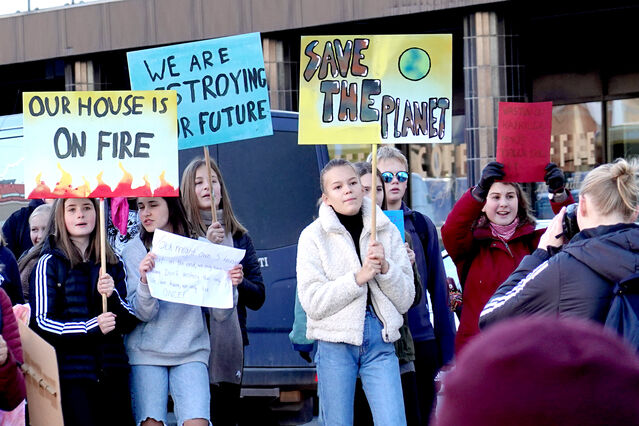Anxiety
7 Ways to Help Kids Cope with Anxiety About Climate Change
"Eco-anxiety" is real and it’s here to stay.
Posted September 28, 2021 Reviewed by Chloe Williams
Key points
- More than three-quarters of people aged 16 to 25 say that they feel that the future is frightening due to climate change, according to a survey.
- Eco-anxiety is a chronic fear of environmental doom accompanied by feelings of loss, helplessness, and frustration about climate change.
- Ways parents can empower their children include seeking out positive research about the environment and adopting green practices at home.

It is no longer refutable. Environmental health and young people's mental health are inextricably linked. Across the globe, children, teens, and young adults experience distress about the state of our planet, global environmental policies, government betrayal, the state of their future, and the future of the Earth. And rightfully so.
A recently conducted groundbreaking survey found that out of 10,000 respondents aged 16 to 25, a staggering 77 percent said that they felt that the future was frightening due to climate change, 60 percent endorsed that they felt "very" or "extremely" worried about climate change, 50 percent stated they had felt afraid, sad, anxious, angry, powerless, helpless, guilty, and 45 percent said their feelings about climate change negatively affected their daily lives. It's time that parents and the psychological community familiarize themselves with the psychological stressor "eco-anxiety" because it's here, and it's here to stay.
The American Psychological Association (APA) describes eco-anxiety as the chronic fear of environmental doom accompanied by feelings of loss, helplessness, and frustration due to one's inability to feel like they are making a difference in stopping climate change. Unlike anxiety, which is typically pathologized, the authors of the survey state, "Although painful and distressing, climate anxiety is rational and does not imply mental illness. It can be seen as a 'practical anxiety' which sometimes leads people to reassess their behavior in order to respond adequately to threats including uncertainty." Though it may seem counter-intuitive for parents, practical anxiety about climate change speaks to the importance and need for parental validation and acknowledgment of their concerns.
The Importance of Validating Your Child's Eco-Anxiety
Unfortunately, the usual "Don't worry about it. That will never happen," or "There's nothing to be afraid of," no longer suffices in this case. The child need only notice the news, attend science class or check social media to learn of the rampant wildfires, earthquakes, floods, tsunamis, and hurricanes caused by the climate crisis. Parents can no longer simply guarantee environmental stability. Furthermore, the landmark survey found that almost 50 percent of people who said they talked with others about climate change reported that other people had ignored or dismissed them. The effects of invalidation have been well documented. They include feelings of worthlessness, despair, confusion, loneliness, depression, and anxiety. The effects of invalidation of eco-anxiety — in addition to the wide range of the emotions that climate anxiety causes, such as worry, fear, anger, grief, despair, guilt, and shame — is a recipe for mental health problems.
7 Ways to Help Kids Cope with Climate Change
Rather than invalidating a child's climate concerns, the following recommendations are aimed at a "take action" or empowerment approach to help reduce feelings of guilt and helplessness, which are often associated with adverse mental health outcomes.
1. Introduce them to positive research about the environment.
Instilling hope about their future and the state of the Earth's future may be the single best way to combat feelings of hopelessness. We all could use a well-deserved break from all of the doomsday articles circulating the internet. The UN Environment Programme (UNEP) often publishes reports about progress surrounding sustainable development goals by all countries.
2. Donate to the right organizations and reach out to local legislators.
Some websites, such as Charity Navigator, help potential donators have accurate and transparent data to inform their giving decisions. These websites can help donors assess which organization can make their dollar generate the most impact by assessing multiple metrics that determine how a charity's money is allocated. Simply search for "highly-rated environmental nonprofits" to see where the majority of your money will be used.
Encourage your child to reach out and write a letter to their local representative about the impact of climate change on their mental health. The survey authors stated, "Our results suggest such action needs to be particularly taken by those in power. To protect the mental health and wellbeing of young people, those in power can act to reduce stress and distress by recognizing, understanding and validating the fears and pain of young people, acknowledging their rights and placing them at the center of policymaking." Encourage your child to reach out and write a letter to their local representative about the impact of climate change on their mental health.
3. Go "plogging."
The word "plogging" comes from the Swedish plocka upp (pick up) and the English word jogging and can be a fun and productive family activity. "Ploggers" can pick up the litter they come across while exercising.
4. Adopt environmentally friendly practices at home.
Eco-friendly living is accessible to all. Recycling, compost piles, eco-friendly cleaning/gardening products, donating used goods, avoiding disposable products, shutting off the lights, and turning off electronics are all straightforward ways to help your child make a big difference in the environment. Utilizing just one of these suggestions can help empower and motivate your child to do more.
5. Plant trees and garden.
Planting trees can reduce levels of pollutants, increase property value, cool our homes, and even help buffer noise pollution. Additionally, spending time around trees and even looking at trees can positively affect mental health. Improved mood, reduced stress, reduced depression, and lower blood pressure are all scientifically documented outcomes from time spent around trees.
Furthermore, a mature tree absorbs carbon dioxide at a rate of 48 pounds per year. In one year, an acre of forest can absorb twice the CO2 produced by the average car's annual mileage. Gardening is equally as beneficial. The NIH asserted that "Health professionals should therefore encourage their patients to make use of green space and to work in gardens and should pressure local authorities to increase open spaces and the number of trees, thus also helping to counteract air pollution and climate change." Gardening at home is not only a form of exercise, but it can help clean the air and soil and protect local wildlife and pollinators.
6. Shop locally.
Not only is a trip to the local farmers' market an excellent family outing, but farmers selling at markets minimize the amount of waste and pollution they create. Many use certified organic practices, reducing the number of pesticides and chemicals that pollute our soil and water.
7. Give up single-use plastics.
According to UNEP, around the world, one million plastic drinking bottles are purchased every minute, while 5 trillion single-use plastic bags are used worldwide every year. Carrying bottles and bags and utilizing plates, dishes, and utensils at home is one great way to avoid single-use plastics in our day-to-day lives.




